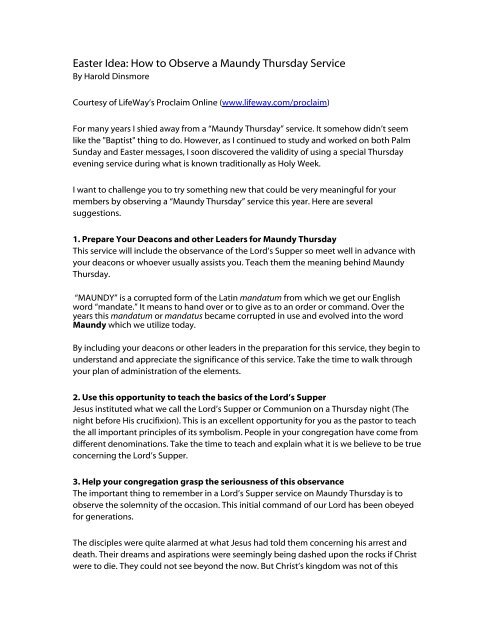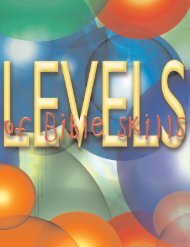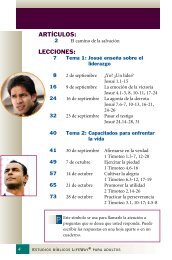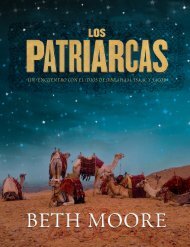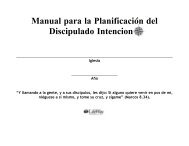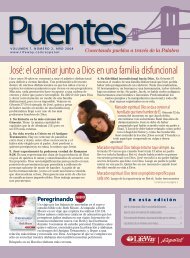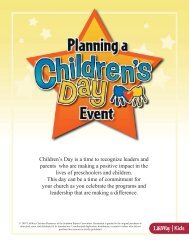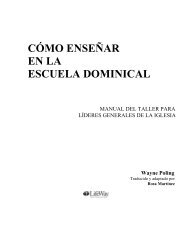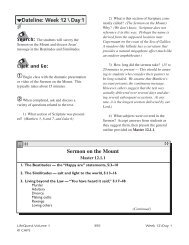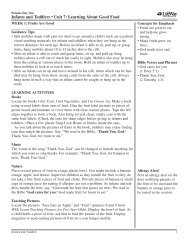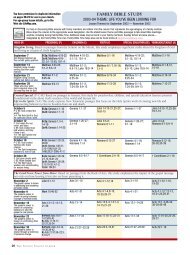Maundy Thursday Worship Service Helps - LifeWay
Maundy Thursday Worship Service Helps - LifeWay
Maundy Thursday Worship Service Helps - LifeWay
Create successful ePaper yourself
Turn your PDF publications into a flip-book with our unique Google optimized e-Paper software.
Easter Idea: How to Observe a <strong>Maundy</strong> <strong>Thursday</strong> <strong>Service</strong><br />
By Harold Dinsmore<br />
Courtesy of <strong>LifeWay</strong>’s Proclaim Online (www.lifeway.com/proclaim)<br />
For many years I shied away from a “<strong>Maundy</strong> <strong>Thursday</strong>” service. It somehow didn’t seem<br />
like the "Baptist" thing to do. However, as I continued to study and worked on both Palm<br />
Sunday and Easter messages, I soon discovered the validity of using a special <strong>Thursday</strong><br />
evening service during what is known traditionally as Holy Week.<br />
I want to challenge you to try something new that could be very meaningful for your<br />
members by observing a “<strong>Maundy</strong> <strong>Thursday</strong>” service this year. Here are several<br />
suggestions.<br />
1. Prepare Your Deacons and other Leaders for <strong>Maundy</strong> <strong>Thursday</strong><br />
This service will include the observance of the Lord’s Supper so meet well in advance with<br />
your deacons or whoever usually assists you. Teach them the meaning behind <strong>Maundy</strong><br />
<strong>Thursday</strong>.<br />
“MAUNDY” is a corrupted form of the Latin mandatum from which we get our English<br />
word “mandate.” It means to hand over or to give as to an order or command. Over the<br />
years this mandatum or mandatus became corrupted in use and evolved into the word<br />
<strong>Maundy</strong> which we utilize today.<br />
By including your deacons or other leaders in the preparation for this service, they begin to<br />
understand and appreciate the significance of this service. Take the time to walk through<br />
your plan of administration of the elements.<br />
2. Use this opportunity to teach the basics of the Lord’s Supper<br />
Jesus instituted what we call the Lord’s Supper or Communion on a <strong>Thursday</strong> night (The<br />
night before His crucifixion). This is an excellent opportunity for you as the pastor to teach<br />
the all important principles of its symbolism. People in your congregation have come from<br />
different denominations. Take the time to teach and explain what it is we believe to be true<br />
concerning the Lord’s Supper.<br />
3. Help your congregation grasp the seriousness of this observance<br />
The important thing to remember in a Lord’s Supper service on <strong>Maundy</strong> <strong>Thursday</strong> is to<br />
observe the solemnity of the occasion. This initial command of our Lord has been obeyed<br />
for generations.<br />
The disciples were quite alarmed at what Jesus had told them concerning his arrest and<br />
death. Their dreams and aspirations were seemingly being dashed upon the rocks if Christ<br />
were to die. They could not see beyond the now. But Christ’s kingdom was not of this
world. He came to die. His birth and life all lead up to this particular point in history where<br />
he would be suspended between heaven and earth.<br />
Paul reminds us in Colossians 2:14, “He erased the certificate of debt, with its obligations,<br />
that was against us and opposed to us, and has taken it out of the way by nailing it to the<br />
cross.” (HCSB) Christ took the sins of the whole world upon himself, so that we might live.<br />
4. Consider the Following Ideas for Your <strong>Maundy</strong> <strong>Thursday</strong> <strong>Service</strong><br />
• Darken the room and have a candle light observance.<br />
• Structure your music to be mournful and solemn.<br />
• Enlist members of the congregation to perform a choral reading of scripture.<br />
• Alter the way you distribute the elements. (Be sure and list what the people can<br />
expect in the bulletin).<br />
• Enlist a team to act out the Lord’s Supper in costume as a mini-play.<br />
• Utilize hymns and songs as an outline for the service.<br />
• Close with the auditorium becoming darkened as all exit silently to contemplate<br />
what Christ was to endure.<br />
• Host a reading of the clinical horror of flogging and crucifixion.<br />
These are just a few things one can do to vary the service from year to year. The focus is on<br />
the mandate and the tenseness of the situation that Christ and His disciples faced. You<br />
want to leave the people with a feeling of despair and mournfulness so as to anticipate the<br />
joy and gladness of Easter Sunday morning.<br />
Pastor Harold D. Dinsmore, MDiv, Midwestern Baptist Theological Seminary, served the<br />
Northland Baptist Church in Kansas City as pastor for 15 years and is currently the pastor of<br />
Bethel Baptist Church in Kansas City. He and his wife Anita have been married for 27 years<br />
and have two grown sons, Joshua and Thomas.<br />
Recommended Scriptures: Matthew 26: 20-30; Mark 14:22-25; Luke 22:14-20; John 6:47-56;<br />
John 13:1-20; 1 Corinthians 11:17-34; Hebrews 9:16-28; Isaiah 53:1-12<br />
Recommended Reading: In Remembrance of Me - A Lord's Supper Manual by by Jim Henry;<br />
Here at Thy Table, Lord by Alton H. McEachern; Communion <strong>Service</strong>s by Robin Knowles<br />
Wallace (Abingdon Press, 2006).<br />
©2007 <strong>LifeWay</strong> Christian Resources. Permission is granted to download, store, print, and distribute this<br />
document for it’s intended use. Distribution for sale is strictly prohibited.<br />
The following pages are compliments of <strong>LifeWay</strong>’s Let’s <strong>Worship</strong> Magazine. Learn<br />
more at www.lifeway.com/magazines
Eagle Heights Church in Oklahoma City<br />
was started in 1994 with the intention<br />
of being innovative. Using a cell-church<br />
model, Bible study is held in homes all over<br />
the city. The congregation is made up primarily<br />
of younger couples and singles. As<br />
the pastor of this young congregation, it is<br />
my privilege to try new and different things<br />
almost constantly. When we began to plan<br />
for the Easter season of 1998, an idea<br />
emerged that ultimately worked quite well.<br />
The idea was to celebrate the last half of the<br />
passion week in the biblical order in which it<br />
happened. We knew that there are some discussions<br />
as to when the events actually happened<br />
in the week, but we chose to go with<br />
the most widely accepted chronological<br />
order.<br />
First, we canceled the normal Wednesday<br />
night service and rescheduled it for<br />
<strong>Thursday</strong> evening. The full and ultimate<br />
result of the plan was to observe the Lord’s<br />
Supper on <strong>Thursday</strong> evening, the crucifixion<br />
on Friday evening, take Saturday night off,<br />
and then celebrate the resurrection on Easter<br />
Sunday morning. The purpose of this article<br />
is to share what was done in the special<br />
<strong>Thursday</strong> evening Lord’s Supper service.<br />
The service was divided into three sections:<br />
the drama, the Supper, and<br />
the object lesson.<br />
Part One<br />
The drama was a recreation of the<br />
event, with a cast in costume on the<br />
church platform portraying Christ<br />
and His disciples and simply performing<br />
the script verbatim from<br />
Scripture in Luke chapter 22. The set<br />
was a simple rendition of the upper<br />
room with only a table and the fixtures<br />
used for the Passover in<br />
Biblical fashion. The drama was<br />
only done to teach that of the Last<br />
Supper and the confrontation of<br />
Judas in the upper room. We included the<br />
scene of Christ washing the feet of the disciples,<br />
which was very moving for the church<br />
to behold live and up close. The drama concluded<br />
with Christ preparing to go out into<br />
the garden of Gethsemane prior to His arrest<br />
and crucifixion. The drama was not a big<br />
production and had only background orchestral<br />
music. It was kept simple to keep the<br />
focus on the message of the Lord’s Supper.<br />
Maunday<br />
<strong>Thursday</strong><br />
Lord’s<br />
Supper<br />
Bobby Boyles<br />
Part Two<br />
As soon as the drama ended I stepped to the<br />
front of the auditorium and explained the<br />
purpose of the Lord’s Supper. This instruction<br />
was brief because of the biblical background<br />
that the drama had provided.<br />
Following the instructions, the drama cast<br />
and I (also in costume) served the Lord’s<br />
Supper to the congregation. This gave people<br />
a feeling of actually being in the upper room<br />
the night that the last supper occurred.<br />
There are several other ways the Supper<br />
could be observed. A church can have an<br />
elaborate explanation of the things used in<br />
the Passover such as leaks and garlic and<br />
other elements, or they can simply have the<br />
fruit of the vine and unleavened bread.<br />
Because of the length of the service with the<br />
drama, we find that it is most effective for us<br />
63
to stay with the two elements that Christ<br />
mentioned in the texts concerning the last<br />
supper. In serving the two elements, the<br />
communion service is similar to that in most<br />
churches—other than the biblical costumes<br />
of the servants.<br />
Part Three<br />
The object lesson, being the third part of the<br />
<strong>Thursday</strong> evening service, was actually<br />
taught during the serving of the elements.<br />
Like most pastors, I’m constantly searching<br />
for ways to make the celebration of the ordinances<br />
more meaningful to those in observance.<br />
This object lesson, which I believe<br />
was given to me by the Holy Spirit, has had<br />
a lasting impact on every congregation and<br />
age group with which I have used it. It takes<br />
little planning and is quite effective.<br />
The planning simply requires going to a<br />
local hardware store and buying enough tenpenny<br />
nails for the entire congregation. We<br />
divided the nails up in small plastic sandwich<br />
bags so that they could be passed to the<br />
congregation by the same men who would<br />
later pass out the elements of the Lord’s<br />
Supper.<br />
During the instructional time before any of<br />
the elements were passed out, I asked the<br />
men to pass out the nails and for everyone to<br />
take one. I also asked the parents to supervise<br />
their children if they had taken a nail.<br />
They were then instructed to take the nail<br />
during the passing and partaking of the elements<br />
and to place the sharp end of it to<br />
their skin at the base of their hand where the<br />
nails likely pierced the Lord’s hands. I asked<br />
them to turn it slightly, not enough to do<br />
actual physical harm to themselves, but just<br />
simply to cause discomfort enough to be<br />
mindful of the suffering that Christ did for<br />
us on the cross.<br />
It is amazing how focused the congregation<br />
became on the nail and the pain that it<br />
can cause. The periods between the elements<br />
and the long periods while the elements are<br />
being passed to the entire congregation were<br />
not filled with music or speech but with<br />
silent contemplation on the price that Jesus<br />
had paid for us all when His hands received<br />
the nails that put Him on the cross. For the<br />
first time, what seemed to be the entire<br />
church had actually focused on the real<br />
meaning of the Lord’s Supper.<br />
The purpose of the object lesson was actually<br />
threefold: (1) It helped people focus on<br />
the price that was paid for us. (2) It prepared<br />
them for the Friday night presentation of the<br />
crucifixion. (3) It caused the Christians who<br />
were present to focus on others who had<br />
made sacrifices to help them to become a<br />
Christian and to grow in the faith.<br />
Towards the close of the service, after the<br />
elements were served and before the closing<br />
song was sung or closing prayer was prayed,<br />
I gave them one final instruction. I asked<br />
everyone who had participated in the Lord’s<br />
Supper service to take the nail that had<br />
helped them to remember the price that was<br />
paid for them and give it to a very special<br />
person who had significant spiritual impact<br />
on their lives. I told them that they had one<br />
nail to give, unless given another nail by<br />
someone whom they had influenced. They<br />
could also give the subsequent nails to others<br />
who had helped mold their Christian life.<br />
It was amazing how long and meaningful<br />
the fellowship after the service was. For over<br />
an hour people were talking and sharing<br />
with each other what they meant to them<br />
spiritually.<br />
The more a person had influenced others,<br />
the more nails they had to give to others<br />
who had helped them to see Christ. This also<br />
served as a motivator for younger Christians<br />
to be disciple makers and witnesses and true<br />
servants. Now in our church when someone<br />
makes reference to how much another<br />
Christian means to them, they say, “I gave<br />
him my nail.” It has come to be a phrase of<br />
honor and value among our fellowship.<br />
Many keep the nails that they were given<br />
displayed as trophies of the sweet grace of<br />
Christ and even give them to someone else at<br />
a later time. It has not been unusual for a<br />
person to come up to a brother or sister in<br />
Christ and give them a nail months after this<br />
service to show them their appreciation for<br />
the sacrifices made in some area of service.<br />
In this way the nail is a symbol of the crucified<br />
life of a Christian servant. It is given to<br />
a person who is unselfishly serving with the<br />
spirit of Christ. Could it be that in this day of<br />
expensive symbols to try to prove our selfworth<br />
such as houses, cars, and jewelry, that<br />
the small nail, simple and unchanging, still<br />
symbolizes the ultimate worth of a Christian,<br />
the selfless servant of Christ?<br />
—————<br />
Bobby Boyles is pastor, Eagle Heights Church,<br />
Oklahoma City, Oklahoma.<br />
64
A <strong>Maundy</strong> <strong>Thursday</strong><br />
Celebration<br />
Mark Puckett<br />
This service requires that each person have a program to follow. Besides the order of service,<br />
the program has song lyrics, responsive readings, and two pictures they will paint (see below).<br />
A simple way to make an appropriate program is to fold four sheets of paper into half sheets<br />
and make a small eight-page program.<br />
The Gathering<br />
People enter and sit at tables in the fellowship hall or other gathering area.<br />
Focus on <strong>Worship</strong><br />
Greet One Another<br />
Join in Praise<br />
“Come to the Table”<br />
by Michael Card<br />
“We Have Come into His House”<br />
by Bruce Ballinger<br />
Explanation of <strong>Maundy</strong> <strong>Thursday</strong><br />
<strong>Maundy</strong> is the from the Latin word for mandate, based on John 15:12,17. Jesus gave His followers<br />
the mandate to love one another. <strong>Maundy</strong> <strong>Thursday</strong> is a time to remember the events of the<br />
Lord’s last evening with His disciples in the Upper Room.<br />
A Call to Celebrate<br />
Hear the Word Revelation 19:1-2a, 4-9<br />
Present this as a reading by two people; one reads all narrative lines, the second one reads all voices.<br />
Explain that as the disciples gathered in the Upper Room, they didn’t understand the tragic events that<br />
would unfold in the following hours. In their minds they were gathering for a celebration—the celebration<br />
of the Jewish Passover.<br />
Celebrate Through Music<br />
“Come, Celebrate Jesus”<br />
by Cloninger & Rosasco<br />
A Call to Serve<br />
Hear the Word John 13:4-5, 12-17<br />
This can be read responsively; leader: verse 4, people: verses 5 and 12, leader: 13-14, people: 15-16, leader:<br />
17.<br />
Speak briefly about Jesus’ model of servanthood. One option is for the pastor to wash the feet of<br />
several members.<br />
A Call to Love<br />
Hear the Word John 15:9-14,16-17<br />
Brief exhortation.<br />
Join in Praise<br />
“They Will Know We Are Christians by Our Love”<br />
by Peter Scholtes<br />
38 Let’s <strong>Worship</strong> Spring 2003
A Call to Remembrance<br />
Remind people that the setting for the evening was the Passover<br />
celebration.<br />
Hear the Word Exodus 12<br />
Responsive reading—leader: verses 1,3,7-8; people: verse 11, leader: verse<br />
12, people: 13, leader: 14.<br />
Briefly discuss the command to paint the door frames of the houses with<br />
the blood of the lamb. Have a picture in the program of a door with a frame.<br />
Have water colors and brushes on the tables. Ask the people to use the red<br />
paint to paint the door frame in their program.<br />
Hear the Word Psalm 105<br />
Read by leader and two readers; leader: verses 1,5,23a,24,26-27; two readers<br />
alternate reading the plaques in verses 28-36; leader: verses<br />
37,39,43,45.<br />
Explain that Christ is the new Passover lamb.<br />
Hear the Word John 1:29; 1 Corinthians 5:7b-8; Revelation 5:6; 7:9-10<br />
Place a picture of a cross in the program at this point. Invitee the people take the watercolors again and<br />
paint three drops of red on the cross: one for each hand and one at His feet.<br />
Focus on <strong>Worship</strong><br />
“Lamb of God”<br />
by Twila Paris<br />
A Call to the Table<br />
Hear the Word 1 Corinthians 11:23-26<br />
Song (soloist or instrumental) as elements are passed: “In Remembrance” (Hymn 365, The Baptist<br />
Hymnal, 1991) or “In Remembrance of Me” (by Cheri Keaggy).<br />
A Call to Love and Serve<br />
Hear the Word Mark 14:26<br />
Join in Praise<br />
“The Bond of Love”<br />
Hymn 384, The Baptist Hymnal, 1991<br />
Dismissal: “Just as our Lord left the Upper Room and led His disciples to the garden to spend the evening<br />
in prayer, so we too, leave the room in silence, with an attitude of prayer and reflection.”<br />
_______<br />
Mark Puckett is pastor of South Gate Baptist Church in Nashville, Tennessee.<br />
Let’s <strong>Worship</strong> Spring 2003 39
Prayer Liturgies<br />
for the Easter Season<br />
Karen Turner<br />
Ash Wednesday Confessional Prayer<br />
Let us pray. (A brief silence.)<br />
Most Holy God,<br />
from the very dust You formed us;<br />
on the dusty path of life You walk with us;<br />
and to dust You shall return us.<br />
Hear now our confessions as we enter this Lenten journey.<br />
For our ways in which we have sinned against You by<br />
believing we are really God ourselves,<br />
Lord, have mercy.<br />
For not loving our sisters and brothers as ourselves,<br />
Christ, have mercy.<br />
For human suffering in which we have had a hand—<br />
by willfulness and neglect,<br />
Suffering Servant, have mercy.<br />
For the church’s lackluster reflection of You in the world,<br />
Great Spirit, have mercy.<br />
For the brokenness of the straying world,<br />
Good Shepherd, have mercy.<br />
Keep us mindful of where we began,<br />
where we are,<br />
and where we are going.<br />
Create in us new hearts and clean spirits<br />
Through Jesus Christ, Amen.<br />
<strong>Maundy</strong> <strong>Thursday</strong> Responsive Prayer<br />
Let us pray. (A brief silence.)<br />
Merciful Savior,<br />
We have traveled this long, dusty Lenten journey.<br />
Our feet are tired, dirty, aching, and calloused.<br />
You have shown us Your love by becoming a humble servant.<br />
Humble us when we try to travel without You.<br />
As Christ has washed us, so let us wash one another.<br />
Humble us when we believe some work is below us.<br />
As Christ has washed us, so let us wash one another.<br />
78
Humble us when we are too proud to accept help, or care, or love.<br />
As Christ has washed us, so let us wash one another.<br />
Humble us when we do not fully receive the gift of Your amazing<br />
and bountiful grace.<br />
As Christ has washed us, so let us wash one another.<br />
Amen.<br />
Good Friday Opening Prayer<br />
Let us pray. (A brief silence.)<br />
Most Holy God,<br />
On this dark night we remember<br />
the suffering and death<br />
of Jesus our Christ.<br />
Grant in Your mercy<br />
that we may draw near to Christ,<br />
hanging in the balance, high on the cross.<br />
Stir in our hearts the memory<br />
that there is no resurrection<br />
without crucifixion.<br />
Into Your hands we commit our spirits,<br />
this night and forever more. Amen.<br />
Resurrection Sunday Opening Prayer<br />
Let us pray. (A brief silence.)<br />
Creator of Life,<br />
in raising Christ Jesus<br />
up, through,<br />
out of, and beyond<br />
the chains of death,<br />
You opened for us the way to eternal<br />
and abundant life.<br />
May our Alleluias on this day<br />
float high above the ceiling of<br />
what we think we know<br />
and transcend to the heaven of<br />
what we believe—<br />
and thus live.<br />
Raise us up!<br />
Renew our lives!<br />
Resurrect our dreams!<br />
Through Jesus Christ our Living Savior,<br />
Amen.<br />
—————<br />
Karen Turner is liturgist and accompanist at Glendale Baptist Church, Nashville,<br />
Tennessee.<br />
79


